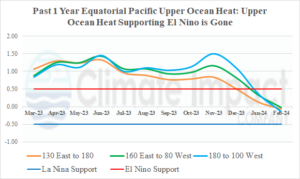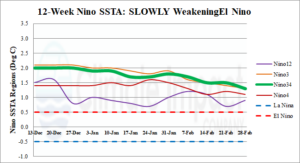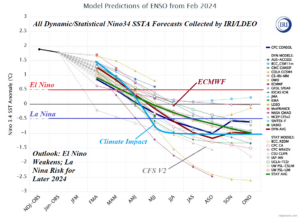Latest EDDI Analysis Reveals Midwest U.S. Drought Concern
03/03/2024, 12:57 pm ESTThe Australia Report: February 2024 soil moisture anomaly verification.
03/06/2024, 8:30 am EST
Fig. 1: The 12-month upper ocean heat in the equatorial Pacific east of the Dateline reveals warmth required to support El Nino is gone.
Discussion: The upper ocean heat required to support El Nino is almost gone east of the Deadline (Fig. 1). Subsurface warmth remains near the Dateline but is sharply cooler in the east-central and far east subsurface region. Anomalous warmth required in the subsurface to sustain El Nino is fading fast. Oceanic El Nino maintains moderate intensity while SLOWLY weakening (Fig. 2). The cooler subsurface waters suggest the Nino34 SSTA will cool dramatically during Q2/2024. The southern oscillation index (SOI) was -1.6 in February supporting the 3rd wave of strong El Nino climate during the 2023-24 El Nino episode (Fig. 3). SOI analogs offer mixed solutions on ENSO phase expectations for the year ahead. A collection of Nino34 SSTA forecasts by the International Research Institute for Climate and Society indicate rapid deceleration of El Nino followed by a reversal to La Nina later in 2024 (Fig. 4).

Fig. 2: The 12-week Nino SSTA tracker indicates oceanic El Nino is weakening slowly.

Fig. 3: The southern oscillation index for the past 12 months compared to recent stronger and weaker El Nino episodes.

Fig. 4: Collection of Nino34 SSTA forecasts to determine ENSO phase from the International Research Institute for Climate and Society.
Summary: Atmospheric El Nino enjoyed a 3rd intensity peak during February although upper ocean heat supporting El Nino continues to diminish quickly. The speed of cooling in the equatorial Pacific subsurface supports an ENSO phase trend into La Nina by mid-year.
